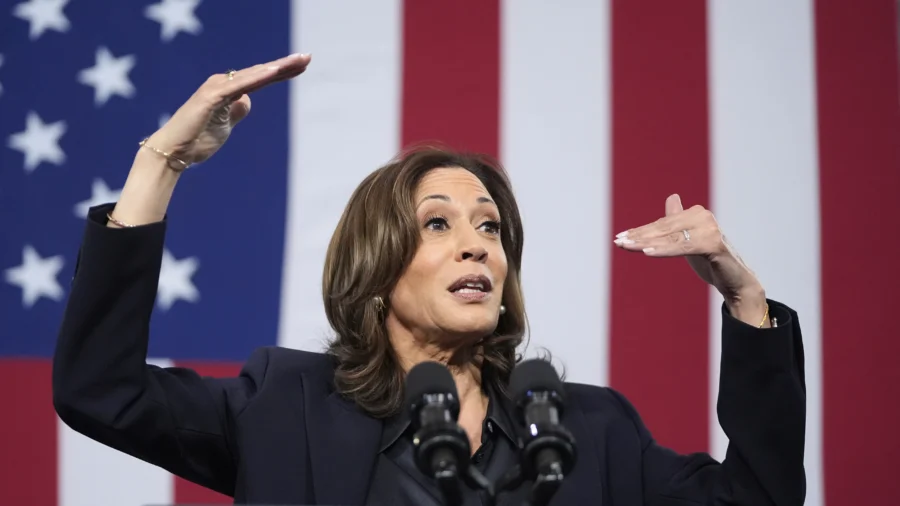REDFORD TOWNSHIP, Mich.—It was the perfect place to welcome the endorsement of the national firefighters union—a gleaming new firehouse in a blue-collar town just outside of Detroit in the key battleground state of Michigan.
But by the time Kamala Harris showed up in Redford Township on Friday, there was no endorsement waiting for her.
By a slim margin, the International Association of Firefighters declined to back any candidate, a reminder of the Democratic nominee’s struggle to lock down the same support from organized labor that President Joe Biden won four years ago. The Teamsters also balked at an endorsement last month.
Harris is still gaining more endorsements than she’s losing. National teachers unions, building trade unions, the AFL-CIO, and the United Auto Workers backed the vice president shortly after Biden ended his run for a second term. And the leader of the Michigan firefighters union, Matthew Sahr, showed up for Harris in Redford Charter Township—although not to bestow the endorsement.
“We could have chosen to stay away. But what kind of message would that send?” Sahr said.
The stumbles reflect the shifting loyalties in American politics as Harris vies with former President Donald Trump for support among working class voters who for years could be more solidly counted on to support Democrats.
In her remarks at the firehouse, Harris didn’t mince words about Trump, saying he “has been a union-buster his entire career” who would launch a “full on attack” against organized labor.
“We know, when union wages go up, all wages go up,” Harris told a small firehouse crowd featuring representatives from different unions. ”And the bottom line is, when unions are strong America is strong.”
Harris said specifically that Trump has expressed support for “right-to-work” laws that often make it more difficult to unionize and that he’d weakened federal employees’ unions. While he was president, Trump used a series of 2018 executive orders designed to weaken federal employee unions’ powers to collectively bargain.
He has expressed support for right-to-work since his initial run for president in 2016—while also making comments more generally supportive of labor rights when speaking to union audiences since then.
She also accused Trump of “making the same empty promises to the people of Michigan that he did before,” Harris said, “Hoping you will forget how he let you down.”
Harris’ remarks followed U.S. dockworkers suspending their strike in hopes of reaching a new contract, sparing the country a damaging episode of labor unrest that could have rattled the economy. A tentative agreement was reached to raise salaries, although other issues still needed to be resolved.
Harris was set to speak later in Flint and her campaign said she’d use those remarks to criticize Trump and his running mate, JD Vance, on auto jobs. She planned to point directly to Vance, who while campaigning in Michigan on Wednesday refused to commit to continue federal support going to the GM plant in Lansing.
Justin Pomerville, the business manager at UA Local 85 in Michigan, said 70 percent of his members’ work hours are tied to the CHIPS and Science Act, which the Biden administration championed and pumped billions of dollars into semiconductor manufacturing. The workers lay complex networks of pipes that carry exhaust, water and chemicals through high-tech facilities. However, Pomerville said that some members aren’t aware of the connection between their jobs and the legislation.
“Unless someone tells them they’re working because of that, they don’t know,” he said.
The Democrats, meanwhile, have increased their support among white-collar professionals while Republicans try to make inroads among voters who didn’t attend college.
During a rally in Saginaw, Michigan on Thursday, Trump said Republicans are now “the party of the American worker.”
The former president also made a trip to Flint last month in an event billed as focusing on the auto industry, a pillar of the battleground state. The two candidates have been in the same cities—and in some cases the exact same venues—within days or weeks of each other.
Trump spent Friday in Georgia with Gov. Brian Kemp, the latest sign that he’s patched up his rocky relationship with the top Republican in a key battleground state. The former president and governor appeared in Evans, Georgia, standing before pallets of goods including bottled water, diapers and paper towels
“I have no doubt that whatever can be done is going to be done,” Trump said. “It’s a lot of effort. It’s a very heartbreaking situation.”
Later in the day, he was holding a campaign event in Fayetteville, in another storm-ravaged state, North Carolina.
Union voters have traditionally leaned toward Democrats, with 56 percent supporting Biden in 2020. But Trump has pushed hard to win over blue-collar workers traditionally represented by some of the biggest unions. He won 62 percent of white voters without college degrees—though only 24 percent of non-white voters without college degrees—in 2020.
It’s frustrating for Democrats, who point to the country’s strong labor market—254,000 jobs were added in September, more than expected—and the White House’s firm support for unions. Biden even joined a UAW picket line last year.

